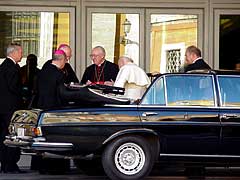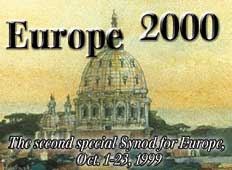European Synod
II
Whatever happened to
collegiality?
By THOMAS C. FOX

Pope John Paul II arriving at the synod hall
photo by -- Tom Fox
Four Swiss Guards stand in front of the synod hall and salute each
bishop who passes by. They recognize cardinals with an additional
click of the heels. When the pope arrives, they stand frozen in salute
as long as he is in sight.
Some mornings Pope John Paul II enters the synod chambers by a side
door, others by the front. One morning this week , John Allen and I
watched from about 30 feet away as the Holy Father’s
chauffeur-driven black Mercedes, drove up to the synod building just
after nine. Sloping steps lead up to the synod hall entrance. A ramp
allows vehicles to drive up the incline.
The arrival of the papal vehicle, adorned with papal coat of arms
and yellow and white Vatican flags on the front fenders, stops
everyone in their tracks. The driver jumps out and pops open the
convertible top. In an instant Pope John Paul stands up. Five men,
including two cardinals, standing nearby, rush to assist him step out
of the car. He emerges slowly stalled briefly by the cardinals who
knell at his feet to kiss his papal ring. Another instant and he
disappears inside.
Someone once called Catholicism “the greatest show on earth.”
At some point, as a church, we need to figure out if the pageantry
will finally save us or do us in.
At the dawn of the 21st century, Roman Catholicism still
governs out of an ancient monarchal model, long discarded by the other
European nations after which it once patterned itself. Efforts to
modernize the governance of church, after strenuous efforts and
substantial majority vote by the bishops at the Second Vatican
Council, have stalled. Indeed, the will of the council to implement
effective collegiality, has not taken place in the 35 years since
Vatican II ended.
Yet the proclamation of episcopal collegiality was widely hailed as
the council’s finest achievement. The principle is that the
bishops form a college and govern the church together with the pope
their head. Reforms in the Roman curia and the establishment of the
Synod of Bishops were to be the instruments of carrying out effective
collegiality.
After a brief attempt in the two years that followed the council,
synods of bishops were effectively stripped of any legislative
influence. They now operate largely in secret, with agendas and
processes drawn up and controlled, by the Roman curia, with little or
no opportunity for serious discussion or debate, being responsible to
virtually none of the People of God who make up the church. When their
work is done, their documents are turned over to the pope for his
considerations.
This is not what the bishops of the Second Vatican Council had in
mind.
By contrast, many church observers say church authority has never
been more centralized and church governance never more contrary to the
wishes of the council. The impact of modern communications with the
power of television, charisma of Pope John Paul II and the pageantry
of the papacy have all worked against collegiality. So too has a
determination by some, but not all, curial members to fight efforts to
share church authority. I heard it said this week from an informed
church source that only about six cardinals have decision-making
authority in the church today. The source added that these men
increasingly do as they wish, acting in the name of the Holy Father
who is less inclined and less able to govern the church.
How bad must it get before it gets better?
Few have answers. Reports of discontent circulate the church.
Bishops were shocked to learn last year that their national
conferences could no longer issue statements on matters of faith or
morals unless they were unanimous, or had Vatican approval in advance.
That Vatican decision was never discussed with the local bishops
before it was announced. The bishops of Asia and Oceana, at synods in
the last year, loudly protested Roman interference in local church
governance. The Asian bishops found it particularly insulting that
carefully studied liturgical documents had to be sent to Rome for
final approval - often ending up in the hands of young Asian
seminarians whom the bishops had sent to Rome in the first place.
The issue of finding the path to effective collegiality stands
before the church as no other issue.
In recent years, archbishops, including John Quinn of San Francisco
and the late Basil Hume of Westminster, and others, have decried the
centralization of authority found in the church today. The subject is
being mentioned at this synod as well and interestingly, church
observers note, by men viewed as church conservatives.
No one, meanwhile, expects any serious change while Pope John Paul
II focuses his dwindling energies of his pontificate on carrying the
message of Christ to far off lands.
Somewhere in the future - maybe within the walls of the next papal
conclave - the issue of collegiality will have to be faced. Or so one
hears it said in Rome today.
National Catholic Reporter, October 8, 1999
|



